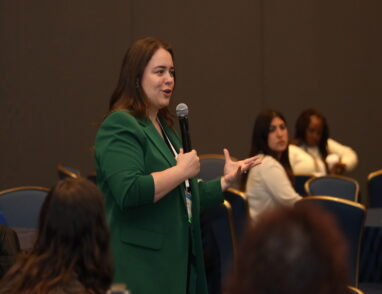Top Takeaways from the Health Equity Forum
March 7, 2024 · Andy Reynolds
Almost 400 quality advocates from 30 states gathered in Los Angeles March 4-5 for NCQA’s first Health Equity Forum. Day 1 focused on the big-picture “why’s and how’s“ of improving health equity, including the role of public policy. Day 2 was an interactive dive into NCQA Health Equity Accreditation. This successful event is a model for future NCQA conferences about building better, more equitable care.
Big takeaways from LA include:
- Embrace collective action. Health equity cannot be achieved by individual actors alone. The work is hard and complex, and demands collaboration across sectors. Enlisting allies also means you’ll have someone to lean on when you tire (Lesson 9). California aligned policymakers, payers and providers—a powerful, successful model.
- Start by looking inward. The road to equity begins at home. Organizations should examine their own tendencies toward bias, such as in hiring. Organizations whose internal demographics and operations embody equity are well positioned to do the same externally.
- Smash silos. Looking inward includes integrating disciplines and departments. In response to NCQA’s mantra—there is no quality without equity—one speaker quipped, “There is no quality without IT!” Indeed, improving quality and equity involves IT, HR, operations—and myriad other parts of the organization.
- Keep interventions flexible. A “one-size-fits-all” approach (what one speaker dubbed “a size medium t-shirt strategy”) can alienate the people you want to help. Understanding what a community needs helps avoid unintended consequences. Adapt your approach! Develop interventions that address the needs and circumstances of the communities you serve.
- Tailor your terminology. The need for flexibility extends to what you call your work. The term “health equity” might not resonate everywhere. Find different starting points to engage different communities. This lesson highlights the importance of culturally competent communication plans. Use words that work.
- Secure, granular data is your superpower. Data equity—collecting, analyzing and interpreting data to promote fair and inclusive decision making—is a cornerstone of health equity. Collecting detailed data helps you “see” people as complex individuals. Be ready to explain (especially to vulnerable and marginalized groups) how you will protect and use what they tell you about their race, ethnicity, language, sexual orientation and gender identity. And respect people’s decision to opt out of giving you that information. That’s part of being flexible and “meeting people where they are.”
- Get ready to play the long game. It took decades, even centuries, for current inequities to calcify. It will take years to fix them. Settle in for steady, sustained effort. When—not if—momentum stalls or you feel discouraged, get “gritty.” Accept that progress won’t be linear. Celebrate small, incremental wins, and draw strength from colleagues who share your commitment to better, more equitable care. (Again, Lesson 9!)
- Connect with clinicians’ original idealism. To secure clinician buy-in to what might be an awkward examination and reset of long-standing practices, help them “get out of their heads and into their hearts.” Most doctors and nurses entered medicine to help people. Turn them into equity advocates by helping them contrast that idealism with reality: The current system often fails people who need them most.
- Inspire and elevate each other. All lessons culminate in the Health Equity Forum’s overarching, animating purpose. Speakers exhorted participants to find inspiration in each other, and to focus on shared goals. Embrace the hope and optimism that working for health equity means you’ve joined a “Justice League” to end unfairness and build a better, healthier society.
View the Visual Notes from the Health Equity Forum or additional information on our Health Equity Resources page.







